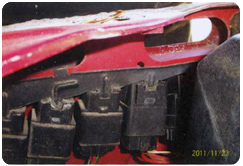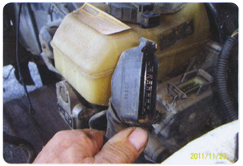Dick Hussey's Tech Corner
How to Diagnose ABS Pump Problems
1987 through 1992 Allantes
Loss of power assist from the ABS pump will result in a hard pedal and little stopping ability on 1987 through 1992 Allantes. If your brakes were working fine and then all of a sudden stopping distance greatly increased and the red brake warning light came on, then most likely you have some problem with the pump. The following should help you determine what the problem is and identify the first step in fixing the problem.
Identify the ABS pump. It is mounted down in front of the master cylinder, on top of the transmission, under the air inlet duct. Two hoses connect it to the front of the master cylinder. What is supposed to happen: When the key is turned on, the pump should come on, run for up to 30 seconds, and then shut off. Right around the time the pump shuts off, the red brake warning light should go out. When the red brake light stays on and there is no power assist for the brakes, one of three conditions is possible:
1.) Loss of brake fluid and the pump is sucking air; or 2.) There is fluid, but the pump is running constantly with the ignition on; or 3.) The pump is not running at all.
If fluid has been lost, the leak must be repaired and both the pump and master cylinder bled after the reservoir has been refilled with fresh clean DOT 3 brake fluid.
If the pump has fluid in the reservoir and runs, but does not shut off; and the red brake warning light in the dash remains on, the pump is defective and needs to be replaced. If the pump does not run at all, further investigation is needed.
Occasionally we have found that the pump has pressurized the system and shut off, but internal master cylinder problems prevent the pressure from getting to the wheels. If the red brake warning light is out but there appears to be no power assist, pump the pedal 25 times with the key off. Make sure the hood is open and turn on the ignition without starting the engine. Listen for the pump to see if turns on even briefly.
If the pump does not appear to run when it should, and the red brake light remains on, the next seep is to see if the pump will run with power directly applied. Disconnect the connector by the motor and BRIEFLY attach 12V+ to the red wire and 12V- to the black wire. (When the pump is hot wired, there is no pressure control shutoff in place. If left hotwired too long, the pump motor will run until it burns up.) If the pump runs when hotwired, then there is a control circuit problem. If the pump does not run, the pump motor has burned up and the pump will have to be replaced.

Shown is the ABS pump that is located down in front of the master cylinder. The air inlet duct has been removed The pump has a feed hose running down from the bottom of the reservoir and then a pressure hose running up to the front of the housing.

Shown are the relays behind the cooling system reservoir on 1990 through 1992 models. The relays are hung on tabs, as they should be. Note that the second relay from the back looks different from the others. That is the ABS pump relay. If the relays are not suspended on the tabs, they can get wet and fail.

Shown is the location of the ABS pump relay on 1981 through 1989 models. The cooling system reservoir has been removed. There are three relays in the area. It is the middle one. Note the shape is different than the other two.

Shows the over voltage protection relay up under the dash. It is attached to a diagonal support bar to the left of the steering column with a cable tie nestled in between the brake control module and the steering column.
Shown is the connector removed from the top of the sensor block. The hook at the top is the end with pin 8 in the long row. Count back two slots to get pin 6, through which the ground connection should be sent to the ABS pump relay.

The control circuit consists of two relays in series and a signal from the master cylinder. The following steps will guide you through determining the problem.
First, locate the ABS pump relay chat is located behind the coolant reservoir inside the right front fender. Ir is the only 50-amp relay in the area. On 1990-1992 models there are 6 relays that should be snapped onto metal tabs. The pump relay is one of the back two, either #5 or #6 from the front. It has much larger spade terminals than the 20/30 amp relays in char area. If the relay is not snapped onto a cab, there is a good chance it has gotten wet and the internal contacts are corroded.
On 1987 through 1989 models, the relay is also behind the cooling system reservoir, under the lip of the right front fender. Ir is usually located in line with the front of the coolant reservoir. Once you have located the relay, remove it from the plug. Ir is normal to see a lot of black crusty deposit between the plug and the relay. This is what is left of the weatherproofing material installed by the factory. There are 4 pins on the relay that come into play: two large wires, a large red and a large red/white. The large red should be hot at all times. BRIEFLY jumping across, between the large red and the large red/white, should make a good pump run. If the pump does not run, check to see if the red wire has battery voltage. If not, there is a fusible link between the front positive chassis junction box that is probably blown. If the pump ran when the red and red/white wires were jumped, then the problem is either a bad relay or a problem with power to either of the coil wires of the pump relay.
If the pump ran when hotwired and with the relay socket jumped, the next step is to investigate the relay socket connections to the relay coil. The small red/white wire in the relay socket should be hot at all times with the ignition on. It should show battery voltage when tested with a multi-meter. If it shows voltage but less than battery voltage, that means the over voltage protection (OVP) relay up under the dash is blown.
The small white wire in the socket should be 12V- or ground whenever the system has less than 2000 lbs internal pressure. Measuring across the two coil wire pins in the socket with the ignition turned on should show battery voltage. If battery voltage is shown across the two coil pins, most likely the relay is bad. If the 12V + shows battery voltage at the small red/ white wire, and the small white wire shows open, then the problem is the ground voltage connection from the sensor block on the side of the master cylinder. To test, remove the 15-pin connector from the top of the sensor block on the side of the master cylinder. Pin #6 should be providing ground. Pin #6 is in the row with 8 pins, two back from the end closest to the firewall. With the ignition on and the relay plugged in and the pump plugged in, BRIEFLY provide ground to pin #6 by using a brad or small wire into the proper pin socket and touching the wire to ground on the strut tower. If everything else in the system is OK, the pump should run when pin 6 is grounded. If it does, then the sensor block on the side of the master cylinder is bad and needs to be replaced. If not, and all other tests have been performed, then there is a wiring problem between the 15 pin connector and the relay socket. If everything shows OK and the pump still does not run as it should, try flexing the wiring at the relay socket with the ignition on. In a few instances bad relay sockets have kept the pump from running.
If replacing the relay, it is imperative that a 50 amp rated relay be used. Whatever parts are needed are available from either Allantesource at (561) 844-3938 or Tom's Allante Store at (619) 807-8770, as well as additional technical assistance if needed.
copyright © 2015 - Allantesource.com - all rights reserved

